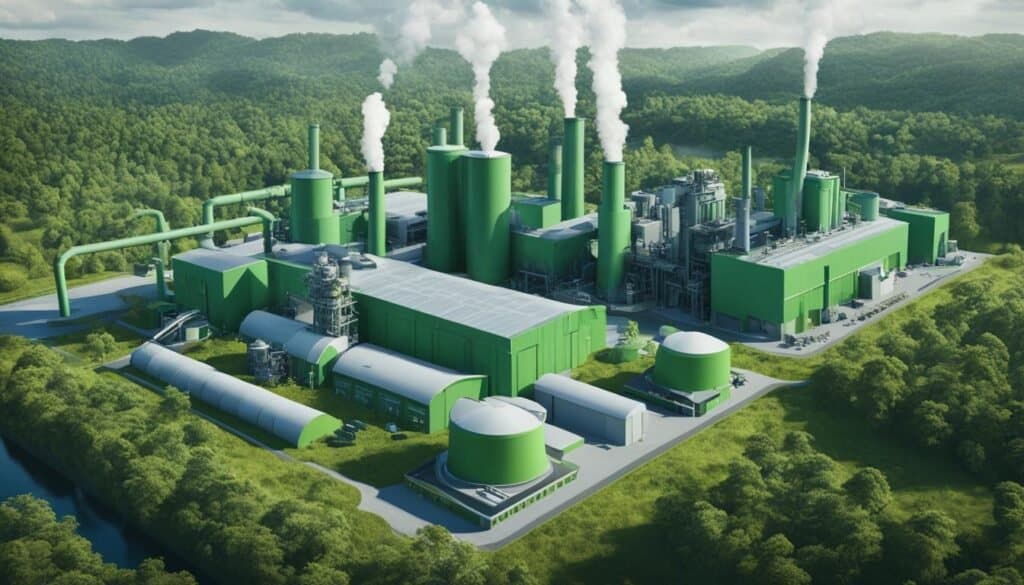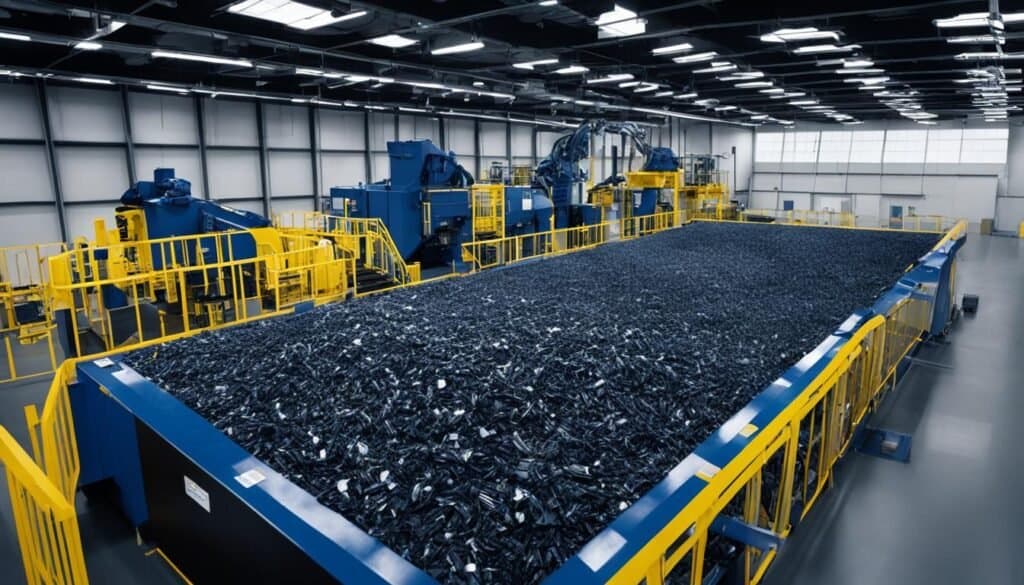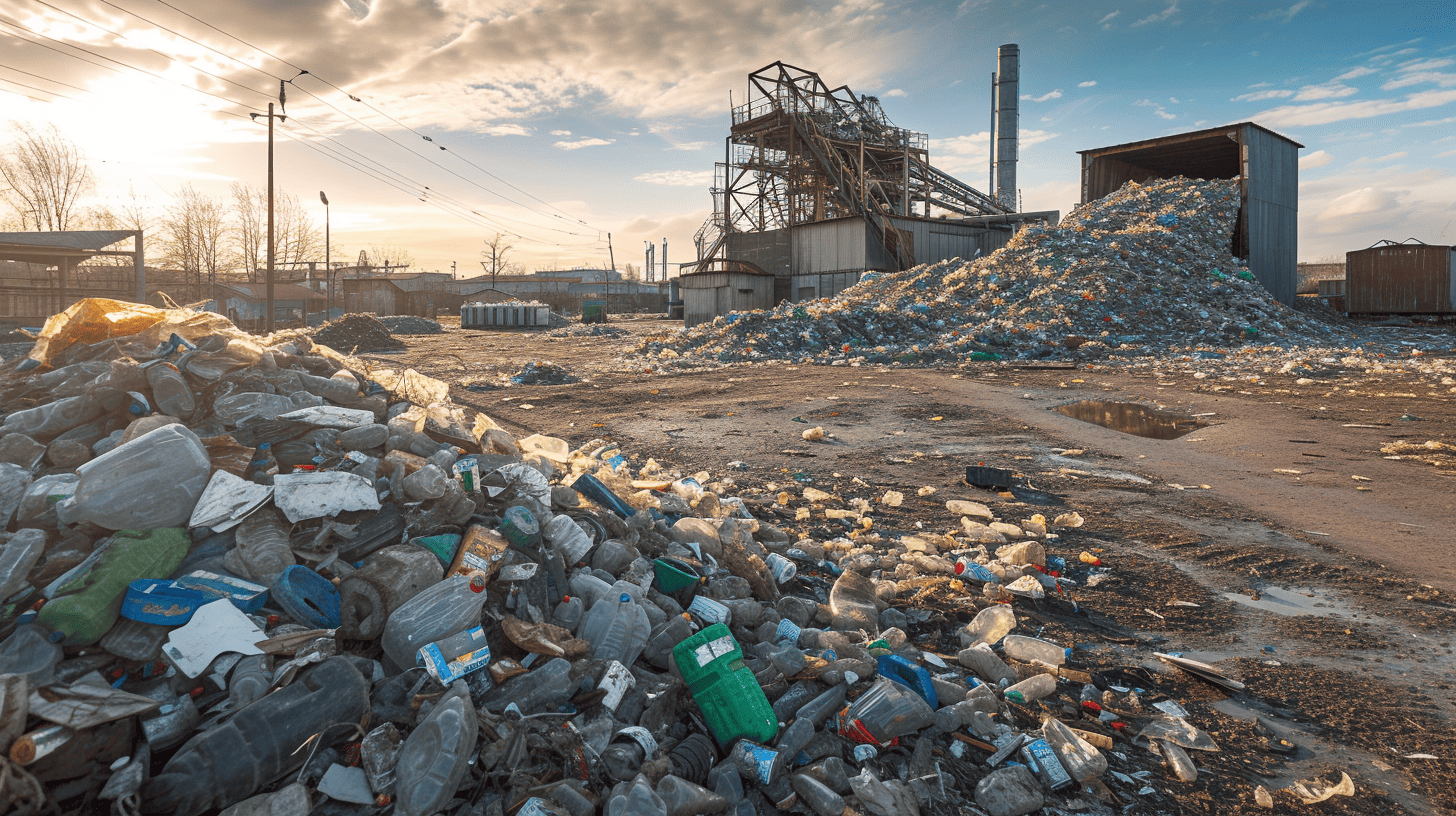In today’s world, it’s necessary for industries to adopt industrial waste reduction best practices to minimize waste, reduce their carbon footprint, and comply with environmental regulations. Waste prevention techniques play a significant role in achieving all of these goals, moving us closer to a zero-waste future. By employing effective waste management programs and embracing innovative methods of waste management, companies can truly make a difference for our planet. Let’s explore some valuable strategies that help reduce the amount of waste generated by industries.
Key Takeaways
- Forming a dedicated green team to identify waste generation sources and develop waste reduction strategies.
- Implementing accurate waste measurement and tracking systems to monitor progress.
- Promoting segregation and recycling programs for efficient waste management.
- Adopting eco-friendly chemical alternatives to reduce the environmental impact of waste.
- Encouraging waste exchange initiatives to repurpose waste materials in a circular economy.
- Innovating efficient disposal methods and landfill management techniques for non-recyclable waste.
- Celebrating waste reduction achievements and continuously striving for improvement in waste management practices.
21 Industrial Waste Reduction Best Practices
Here is a list of 21 industrial waste reduction best practices:
- Source reduction – Reduce waste at the source by upgrading raw materials, improving supply chain efficiency, buying new equipment that produces less scrap, etc. This is the most preferred waste reduction method.
- Reuse waste materials – Reuse scrap materials, byproducts, and waste in the production process before recycling or disposal. This conserves resources and reduces costs.
- Recycling – Segregate recyclable materials like paper, plastic, glass, metals, e-waste, etc. and send to recycling facilities. Recycling turned $90 billion in annual revenue in 2019.
- Compost food and yard waste – Composting organic waste like food scraps and yard trimmings can divert up to 30% of waste2.
- Energy recovery – Incinerate non-recyclable combustible waste to generate electricity. 130 U.S. waste-to-energy plants dispose of 90,000 tons of waste a day.
- Chemical treatment – Treat waste to reduce toxicity before landfilling. Treatment removed toxicity from 12% of total hazardous waste generated in 2017.
- Proper landfilling – Send non-hazardous, non-recyclable waste to sanitary landfills to prevent groundwater contamination. Landfills disposed of 139 million tons of waste in 2018.
- Responsible hazardous waste disposal – Follow regulations to safely transport and dispose of hazardous industrial waste like chemicals, medical waste, e-waste, etc.
- Employee training – Train employees on proper waste segregation, handling, and disposal procedures. Studies show training can reduce waste by 14-38%.
- Production planning – Plan production efficiently to reduce overproduction and minimize raw material waste. Studies show planning can reduce waste by 7-15%.
- Inventory management – Use inventory systems to track shelf life and rotate stock to minimize expired/damaged goods. This can reduce waste by up to 30%.
- Packaging reduction – Work with suppliers to use returnable packaging systems and reduce packaging waste. On average, this cuts costs by $1.66 per unit.
- Buying recycled – Purchase recycled paper, plastic, glass, and other materials to close the recycling loop and support circular economy. The recycling industry employs over 534,000 people.
- Fixing leaks – Repair water and air leaks quickly, as leaks account for up to 30% of water waste and 20% of compressed air waste.
- Shutting off equipment – Turn off conveyors, lights, AC, and other equipment when not in use. This can reduce energy waste by 10-20%.
- Preventative maintenance – Regular equipment maintenance increases efficiency and prevents breakdowns that lead to defective products and waste. Studies show this can reduce waste by 12-18%.
- Lean manufacturing – Apply lean concepts to identify and eliminate all forms of waste including defects, inventory, motion, transport, overproduction, etc. Lean manufacturing has been shown to reduce waste by 14-87%.
- Waste exchange programs – Exchange waste materials between companies so one company’s waste becomes another’s raw material. Over 1,100 materials exchanges divert millions of tons of waste a year.
- Waste audits – Conduct regular waste audits to identify top waste streams and target them for reduction. Audits can reduce waste disposal costs by 20-60%.
- Employee engagement – Encourage employees to share waste reduction ideas. Engaged employees can help cut waste generation rates by up to 43%.
- Continual improvement – Continually monitor waste streams and reduction methods. Improvement programs have achieved up to 6.4% annual reduction in waste generation.
Establishing Your Green Team and Assigning Roles
In managing industrial waste, forming a green team is a crucial step in optimizing work processes and sustainability initiatives. This multidisciplinary waste management taskforce is responsible for the development and execution of strategies, as well as monitoring performance. Comprising employees from various departments and production stages, the green team plays a pivotal role in reducing waste and minimizing environmental impacts.
Creating a Multidisciplinary Waste Management Taskforce
To assemble an effective green team, it is essential to involve representatives from diverse departments within the organization. In this way, multiple perspectives and expertise can be integrated in devising comprehensive waste reduction strategies.
Medbws emphasizes integrating lean manufacturing principles to optimize industrial processes and minimize waste generation.
Ensuring that all relevant stakeholders are part of the team enhances collaboration and fosters a culture of sustainability throughout the workforce.
Defining Roles and Responsibilities for Sustainability Initiatives
The green team must clarify distinct roles and responsibilities for the implementation of sustainability initiatives. This entails assigning specific tasks and setting clear goals to help achieve the overall waste reduction objectives. By empowering the team members and establishing accountability, the green team is better positioned to drive positive change and make a tangible impact on the company’s waste management program.
Monitoring Execution and Adjusting Strategies as Necessary
Regular monitoring and performance evaluation are vital components of the green team’s responsibilities. Tracking the progress of implemented initiatives and conducting periodic assessments enable the team to identify areas for improvement and optimize approaches. Effective communication and timely response to changing circumstances are critical in maintaining the team’s alignment with the organization’s overarching aims and ensuring a successful waste reduction program.
| Green Team Roles | Responsibilities |
|---|---|
| Waste Reduction Coordinator | Overseeing the implementation of waste reduction strategies and ensuring that targets are met |
| Sustainability Analyst | Analyzing waste generation data and identifying areas for improvement |
| Recycling Specialist | Implementing recycling programs and conducting employee training sessions |
| Communications and Engagement Manager | Developing communication materials and fostering a culture of sustainability within the organization |
In summary, the establishment of a green team and the careful assignment of roles play crucial roles in enhancing the effectiveness of an organization’s waste management program. By fostering a culture of sustainability and optimizing work processes, businesses can significantly reduce waste and minimize their environmental impact. Therefore, investing in the formation of a green team should be among the top priorities for any organization seeking to better manage its industrial waste.
Developing Robust Waste Measurement and Tracking Systems
Implementing robust waste measurement and waste tracking systems is a crucial step towards reducing industrial waste. To accurately measure and monitor waste generation, it is essential to identify waste sources within different departments and processes. Collecting and analyzing data aids in setting focused waste reduction targets and gauging the effectiveness of waste management strategies.
Furthermore, data accuracy in waste tracking systems plays a vital role in monitoring progress and improving overall waste management practices. Sharing these insights within the company can foster a collective awareness and motivation to reduce waste volumes and streamline operations.
- Set up centralized mechanisms for capturing waste generation data within the organization.
- Ensure that accurate data is available for all waste streams and types in real-time.
- Develop performance indicators that can be easily tracked and understood by everyone involved in waste management.
- Create transparent communication channels for sharing insights and improvements across functions.
- Establish a feedback loop to empower employees to contribute to waste reduction goals.
Robust waste measurement and tracking systems provide a foundation for identifying opportunities to minimize waste, setting actionable targets, and evaluating the success of implemented waste management strategies.
By integrating waste measurement and tracking systems within company operations, organizations are better equipped to monitor progress, leverage accurate data, and share insights with employees. As a result, industries can collectively drive changes that ultimately reduce waste and optimize their waste management practices.
Industrial Waste Reduction Best Practices

Industrial waste reduction is crucial for businesses to minimize their environmental impact and ensure effective waste management processes. Success in this mission often entails implementing segregation and recycling initiatives, opting for eco-friendly chemical alternatives, and embracing the circular economy through waste exchange programs. Let’s explore these best practices and their significance in decreasing landfill dependence.
Implementing Segregation and Recycling Programs
Establishing dedicated bins and recycling programs is an efficient method for encouraging segregation and recycling at the source. By separating recyclable materials like glass, plastic, paper, cardboard, and concrete, companies facilitate the repurposing of such materials into new products. This systematic approach to recycling results in significant waste reduction and resource conservation.
Adopting Eco-Friendly and Green Chemical Alternatives
To reduce toxicity and environmental impact, companies can turn to green chemical alternatives in their manufacturing processes. Choosing eco-friendly chemical substitutes helps minimize the harmful effects of industrial waste on the environment and our health. By opting for these sustainable solutions, businesses actively contribute to a cleaner, greener future for all.
Promoting a Circular Economy through Waste Exchange Initiatives
Embracing circular economy principles serves to minimize manufacturing waste and maximize resources. Waste exchange initiatives are an excellent way to enact these principles, as these programs enable by-products from one process to serve as inputs for another. Implementing such initiatives not only cuts down landfill dependence but also supports sustainable resource use and fosters environmental stewardship within the company culture.
| Best Practice | Benefits |
|---|---|
| Segregation and Recycling Programs | Waste reduction, resource conservation, and environmental responsibility |
| Green Chemical Alternatives | Reduced toxicity, minimized environmental harm, and eco-friendly processes |
| Waste Exchange Initiatives | Sustainable resource use, decreased landfill dependence, and circular economy promotion |
By adopting these waste reduction best practices, companies can take concrete steps towards minimizing their environmental footprint and fostering a more sustainable future.
Innovation in Efficient Disposal and Landfill Management

As industries work towards the goal of efficient waste disposal, innovative solutions play a significant role in realizing this ambition. One such innovation is the incorporation of waste chutes in buildings to streamline the disposal process. Waste chutes ensure the swift and safe transportation of non-recyclable waste to designated areas for proper disposal.
For non-hazardous waste that cannot be recycled, landfill management is essential. Proper waste containment and management practices can minimize the ecological impact of industrial waste. Well-managed landfills facilitate waste decomposition through compacting and burying waste in controlled environments. This approach helps to reduce the risk of water, air, and soil pollution associated with improper waste disposal.
Moreover, generating electricity from waste decomposition products adds an eco-conscious layer to the benefits of innovative landfill management. Some landfills harness gases emitted during waste decomposition and convert them into electricity. This sustainable approach contributes to reducing our dependence on traditional energy sources.
| Method | Description | Benefits |
|---|---|---|
| Waste Chutes | Vertical channels for waste transportation in buildings | Speedy and safe waste disposal, minimizing human efforts |
| Proper Landfill Management | Controlled containment and burial of waste, minimizing environmental harm | Reduced pollution and ecological disruption |
| Generating Electricity from Waste Decomposition | Converting waste decomposition gases into electricity | Sustainable energy generation and resource utilization |
In conclusion, focusing on innovative solutions for efficient waste disposal and landfill management is vital in reducing the environmental impact of industrial operations. By implementing effective disposal methods and harnessing the potential of waste decomposition, industries can take a step closer to achieving a sustainable and eco-friendly future.
Conclusion on Industrial Waste Reduction Best Practices
The journey towards minimizing industrial waste and adopting sustainable industrial practices is both continuous and ever-evolving. Several waste reduction achievements have already been made, and it’s essential to persistently evaluate and improve practices to stay on the right track. In an era where environmental responsibility is increasingly significant, industries must be committed to addressing future challenges and growing with innovative solutions.
Reflecting on the Journey Towards Waste Reduction
Implementing waste reduction best practices has brought about numerous positive changes in various industries. From establishing dedicated green teams and waste tracking systems to segregating waste for recycling, industries have taken significant strides in reducing their carbon footprint. This process demands ongoing cooperation and education to maintain the momentum forward in waste reduction.
Future Challenges and the Path Forward for Sustainable Industrial Practices
As the industrial landscape continues to change, new challenges will arise, necessitating further integration of sustainable practices into manufacturing and waste management protocols. Industries need to remain adaptable and ready to explore innovative approaches to waste management and embrace new waste reduction technologies to increase efficiency and lower their environmental impact.
Celebrating Achievements and Continuous Improvement in Waste Management
Acknowledging the progress made in waste reduction is crucial for inspiring continued efforts toward environmental responsibility. By celebrating achievements and promoting a culture of continuous improvement, industries can remain motivated to strive for a greener future and create more efficient and effective waste management systems, benefiting both their operations and the planet.
FAQ on Industrial Waste Management
Q: What are some effective ways to reduce industrial waste?
A: Some effective ways to reduce industrial waste include source reduction, recycling, composting, and implementing waste management software.
Q: Why is it crucial for manufacturing businesses to reduce or eliminate waste?
A: It is crucial for manufacturing businesses to reduce or eliminate waste to minimize environmental impact, improve sustainability, and reduce operational costs.
Q: How can industrial waste be effectively managed and disposed of?
A: Industrial waste can be effectively managed and disposed of through proper segregation, reuse of materials, recycling, utilizing waste management services, and implementing waste minimization techniques.
Q: What are some common waste disposal methods used in manufacturing industries?
A: Common waste disposal methods in manufacturing industries include landfill disposal, incineration, recycling, and resource recovery through waste-to-energy processes.
Q: How can the volume of waste produced in manufacturing processes be reduced?
A: The volume of waste produced in manufacturing processes can be reduced through process optimization, material substitution, efficient use of raw materials, and implementing lean manufacturing principles.
Q: What are the best practices for managing hazardous waste in industrial settings?
A: Best practices for managing hazardous waste in industrial settings include proper labeling, storage, handling, and disposal in compliance with environmental regulations and standards.
Q: How can organic waste from manufacturing operations be effectively converted into fertilizer?
A: Organic waste from manufacturing operations can be effectively converted into fertilizer through composting, utilizing aerobic or anaerobic digestion processes, and partnering with organic waste management companies.
Q: What are some strategies to implement a zero-waste approach in a manufacturing business?
A: Strategies to implement a zero-waste approach in a manufacturing business include upstream waste prevention, reusing materials, promoting a circular economy, and engaging employees in waste reduction initiatives.
Q: What role does waste and recycling services play in reducing industrial waste?
A: Waste and recycling services play a crucial role in reducing industrial waste by providing comprehensive waste management solutions, recycling options, and sustainable waste disposal methods.
Q: How can manufacturing businesses effectively monitor and analyze their waste reduction efforts?
A: Manufacturing businesses can effectively monitor and analyze their waste reduction efforts by utilizing waste management software, conducting waste audits, tracking key performance indicators, and implementing continuous improvement strategies.





Leave a Reply